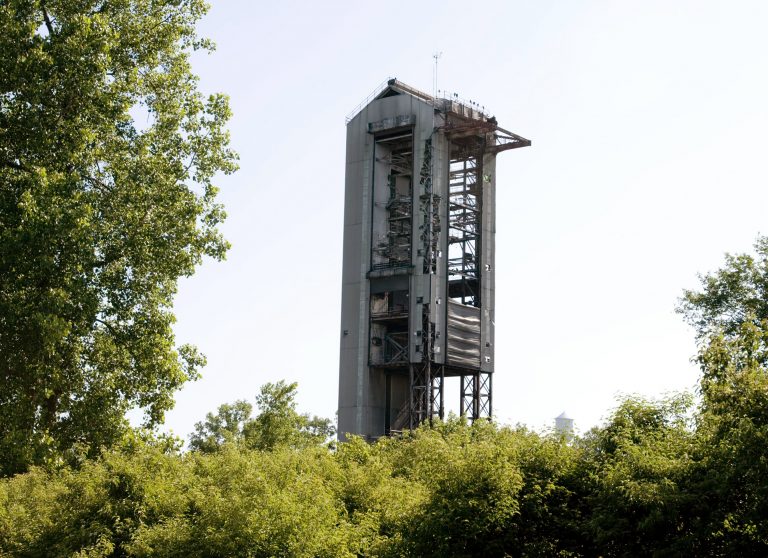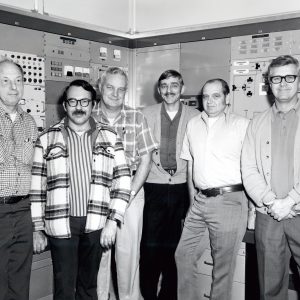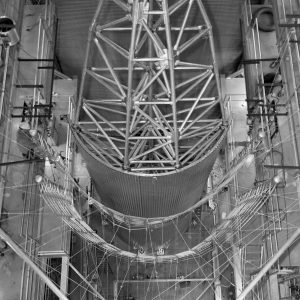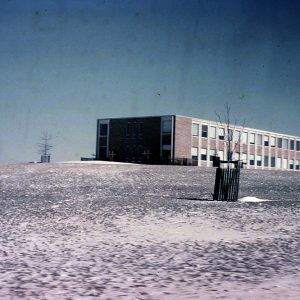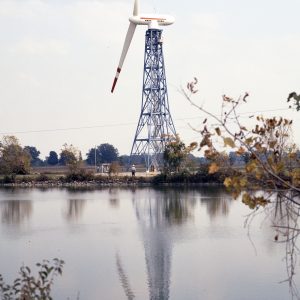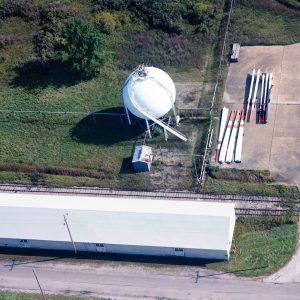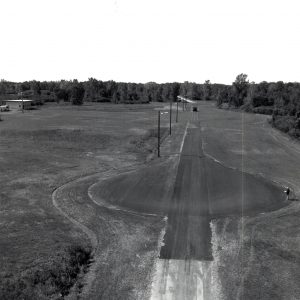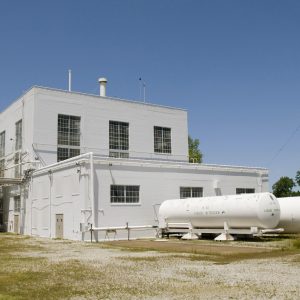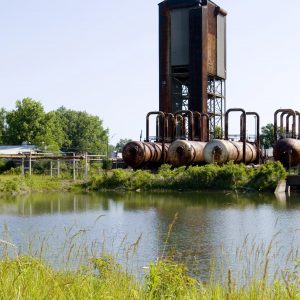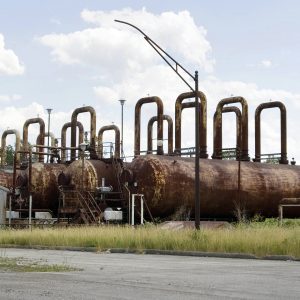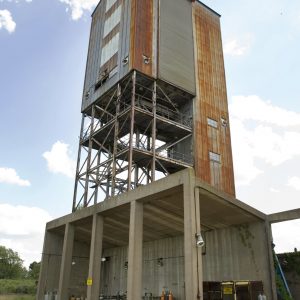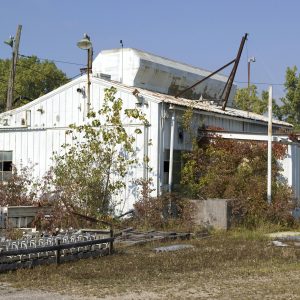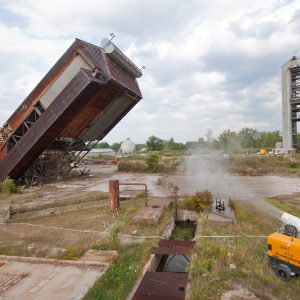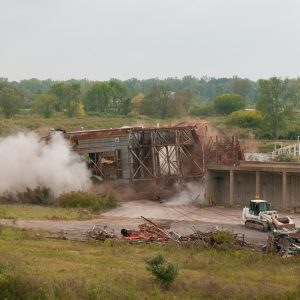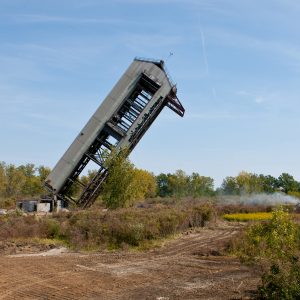Final Years
The steady reduction of NASA’s budget in the late 1960s and early 1970s coincided with the agency’s decision to develop the space shuttle. NASA shelved other major programs, such as a space station and long-duration human journeys to other planets. This eliminated the near-term need for a nuclear rocket. In December 1972 NASA canceled all of its nuclear propulsion and power programs, resulting in the closure of Plum Brook Station [today, the Neil Armstrong Test Facility].
There was very little activity at Plum Brook until the late 1980s when Lewis Research Center reactivated four test sites and resumed testing. The center did not bring the Rocket Systems Area sites, which had fallen into disrepair during the interim, back online. In the 2010s NASA demolished the Rocket Systems Area as part of the agency’s effort to eliminate its unused structures. Plum Brook Station, however, continues to support NASA and industry with its four large test facilities today.
Plum Brook Station Closure
Neither the Atomic Energy Commission nor NASA Lewis had been given any indication that the nuclear propulsion program would be cancelled until the budget was officially announced on January 5, 1973. It was 1 year to the day after the approval of the shuttle and just 17 days after the splashdown of the final Apollo mission. Lewis Director Bruce Lundin traveled to Plum Brook that day to personally inform the staff that the station would be closed down. Activities at the reactor were terminated immediately, and the other facilities would shut down by fiscal year 1974.
Engineers carefully deactivated the facilities in such a way that they could be restored in the future. This included de-energizing electrical systems, deactivating boilers, shutting down gas systems, depressurizing air service, etc. Technically, this allowed the mothballed test stands to be reactivated within 3 months. Meanwhile Plum Brook continued worked to complete several tests during this period, including testing of the Centaur Standard Shroud for the upcoming Viking mission.
By May 1974 the staff had mothballed all of the Rocket Systems Area sites. Some staff members found new positions at Lewis, but hundreds of others were soon out of work. Lewis set up a job placement office at Plum Brook to assist those affected. Lewis management also actively solicited other agencies and institutions to use Plum Brook for their test programs. The job placement activities went well, but the attempts to elicit outside interest in Plum Brook failed.
Documents
- Plum Brook Closure Press Release (1973)
- Termination of Plum Brook Activities (1973)
- Bruce Lundin Talk to Plum Brook Staff (1974)
- Plum Brook Phased Down article (1974)
- Dugan Helps Plum Brook article (1973)
- Capabilities and Facilities of Plum Brook (c1970)
Standby Years
By 1975 there were only a handful of NASA employees left at Plum Brook Station to supervise the contractors that maintained the facilities. Other Federal agencies, including the Environmental Protection Agency, the Federal Bureau of Investigations, and the Department of the Interior, set up offices in the empty Engineering Building. The center’s continued efforts to entice outside groups to utilize the inactive facilities remained ineffective. By the late 1970s, NASA decided to continue the maintenance of the reactor, Space Power Facility (SPF), Spacecraft Propulsion Research Facility (B–2), Cryogenic Propellant Tank Facility (K Site), and the Hypersonic Tunnel Facility (HTF), but ceased protecting the other Rocket Systems Area sites.
In the 1970s the center expanded the scope of its work into new areas, such as renewable energy sources. As a result, Lewis partnered with the Energy Research and Development Administration (ERDA) to construct a series of experimental large horizontal axis wind turbines. The first was a 100-kW experimental wind turbine at Plum Brook that Lewis researchers erected and operated. Between 1975 and 1985, the researchers investigated several different configurations on the machine. NASA and ERDA constructed larger wind turbines at other sites around the country to study the integration of wind energy into the local power grids. The program demonstrated several technologies employed by large wind turbines today. Overall, however, Plum Brook remained quiet.
Documents
- Potential Use of Plum Brook Facilities (1973)
- Potential Programs for Plum Brook (1973)
- Plum Brook Station Review (1976)
- Wind Turbine Tenth Anniversary (1985)
- NASA Large Wind Turbine Program (1982)
- Plum Brook Chronology (1940-85)
- Plum Brook Facilities Status (1985)
Demolition of the Sites
In 1985 the Office of Management and Budget recommended that NASA relinquish control of Plum Brook Station. A multiagency commission, however, reviewed the assessment and came to a different conclusion. They called on NASA to restore the test facilities at Plum Brook and resume operation. Lewis reactivated the B–2 vacuum chamber in 1987, SPF and K Site in 1988, and the HTF in 1993. The reactor and Rocket Systems Area remained shuttered. In 2007 the Cryogenic Components Laboratory replaced K Site.
In 2004 NASA began funding the demolition of unused facilities across the agency. Glenn began making plans to remove a number of its old test sites, including the Rocket Systems Area at Plum Brook. The sites, which had been exposed to the elements for years, were beyond restoration. In addition, safety officials considered several sites to be hazards. In November 2004 the Dynamics Stand (E Stand) became the first to fall. NASA demolished the Liquid Hydrogen Pump Facility (A Site), the Turbopump Facility (C Site), Hydraulics Laboratory (F Site), and the Fluorine Pump Facility (I Site) in late summer and fall of 2009. The Gas Handling Area was removed in March 2010, followed by the High Energy Rocket Engine Research Facility (B–1) and Nuclear Rocket Dynamics and Control Facility (B–3) facilities in fall 2010. The center completed the effort with the demolition of the H Control Building, K Site’s control building, and the J–5 hortonsphere in late 2012. In addition, the center decided to begin removing the Plum Brook Ordnance Works (PBOW) concrete bunkers that had stored munitions during World War II and NASA records and equipment in later years.
Documents
- PBS is Lewis Best Secret article (1991)
- Plum Brook Current Facilities
- Plum Brook Able to Pay Own Way (1996)
- NASA Ohio Preservation Office Agreement (2012)

